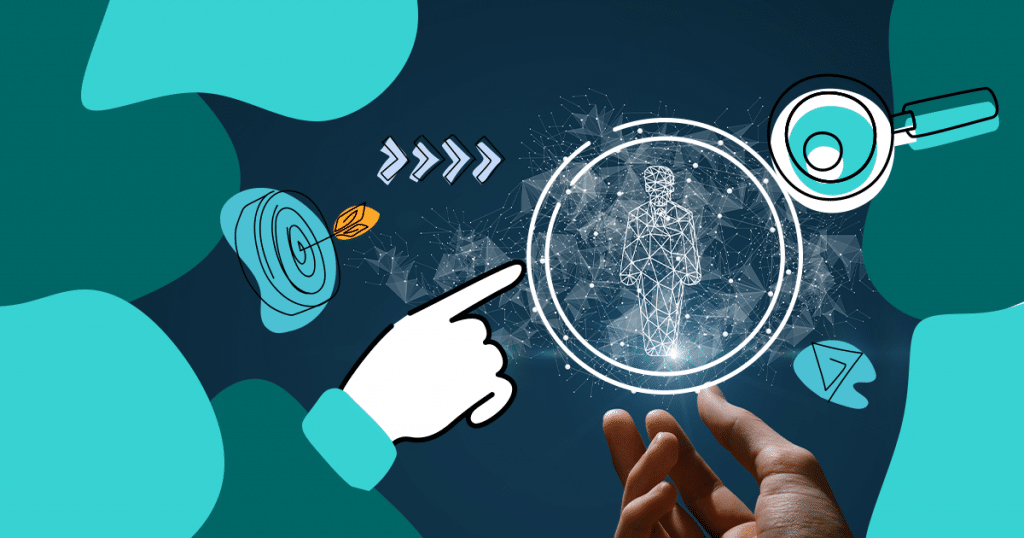In today’s rapidly changing world, improving the customer experience is at the forefront of marketing considerations.
Consumers want to connect with companies who understand who they are and what they need and want. Also, they are constantly seeking products and services that recognize them as individuals.
Because of this, marketing campaigns created for audience segments or even personas may not be enough anymore.
While you can’t read every customer’s mind, you can anticipate and possibly even exceed the possibilities for them through hyper-personalization marketing.
Essentially, hyper-personalization taps into human wants and needs individually.
It combines data, analytics, artificial intelligence, machine learning, and automation to create unique interactions.
The focus, then, is on customer-centric, data-driven marketing to reach individual customers in new ways.
Pivoting to this more personalized approach is accelerating among brands, and it appears to be working. Find out more below.
What is Hyper-Personalization Marketing?
Hyper-personalization marketing is a shift away from the one-size-fits-all strategy and moves closer to providing an individual experience for each customer.
With it, you maximize the use of all your collected real-time data and provide customers with products, services, and content that are more relevant to them.
This hyper-personalization method gives a brand opportunities to engage customers in more meaningful ways and improve the overall customer experience, one customer at a time.
It also leads to a deepening of current customer relationships, as well as attracts and builds new ones.
Utilizing Artificial Intelligence to sift through your collected data, you can then create communications geared toward certain customers and know the best ways to share them, including when, where, and through which marketing channel.
While personalized marketing isn’t exactly new and has proven successful, going one step further with hyper-personalization can do more.
It does take time to develop a hyper-personalized marketing strategy, however, but it doesn’t have to happen all at once.
You can start with something like recommendation engines and make you’re way up to predicting preferences of your customers and tailoring products and pricing to fit them specifically.
Regular Personalization vs. Hyper-Personalization
Most people no longer tolerate communications that only seek to sell products or services. Something must resonate with them, and personalizing an offer or informational content is a step in the right direction.
There are, however, differences between regular, or standard, personalization and hyper-personalization.
Regular personalization focuses on the basic information about a customer online, including names, locations, and other demographics.
For instance, that email your brand sent out recently addresses each customer by name. Or, the cart on your e-commerce site starts out by addressing the customer directly, alerting them to items awaiting their completed purchase.
Regular personalization also relies on customer data to gain basic insights and make a marketing campaign more relevant to customers’ needs or interests.
In contrast, hyper-personalization is a more refined form of personalization, pulling from real-time and behavioral data and providing an even more individualized customer experience.
Hyper-personalization utilizes more advanced and complex data, including:
- Customer’s browsing activity.
- Actual purchasing behavior.
- Customer’s affinity (e.g., free templates, free samples, or discounts).
- Active times (e.g., a customer logs on or makes purchases).
- Notifications that result in higher engagement.
It also:
- Leverages real-time data, AI, and automation to deliver a highly individualized online experience, providing more relevant services, products, or content individually.
- Relies on insight-driven decisions to determine types of interactions for each customer.
- Focuses on creating highly relevant customized campaigns for various products and services.
Hyper personalization allows brands to utilize data, including their own and that of third parties, to better understand customers and their individual behaviors and preferences.
In sum, general personalization works for customer segmentation or based on personas, but hyper-personalization goes further, focusing on meeting the customer on a more individual level.
Why Does Hyper-Personalization Matter for Business?
It’s becoming more and more important that customers feel a connection with the businesses they interact with today.
This mindset and increasing need for emotional connection directly affects your business and is why hyper-personalization matters.
So, what can hyper-personalization do for your business?
Reduce Marketing Costs in the Long-Run
As the digital marketing space continues to fill with more companies, products, and services, your instincts and current practices may tell you to put additional content and offers out there to reach customers as a way to compete.
Yet, increased spending on your marketing isn’t the answer anymore. It’s what you do with your marketing dollars that matters.
By utilizing hyper-personalization, you can better reach your targeted audience, giving them what they want and need, and stop wasting efforts on the whole, who are never likely to convert.
Initially, this approach may add to your costs, especially as you discover better ways to analyze data and utilize the newest AI-driven technology and automation possibilities.
Eventually, though, it will reduce marketing costs by creating a more focused and successful strategy, as well as a streamlined workflow.
Download this post by entering your email below
Improve Brand Marketing ROI
While the use of AI and automation saves you both time and resources, it also offers more relevant benefits to your customers and improves their overall experience with your brand.
In addition, the use of hyper-personalization can directly impact your brand marketing ROI, and in a good way.
As a matter a fact, accounting and professional services firm Deloitte reports hyper-personalization can deliver an ROI of anywhere up to 80%.
Maximize Revenue
With more sales occurring online these days, you need to find a way to attract customers and maximize revenue at the same time.
Hyper-personalization can drive online sales and maximize revenue by:
- Focusing more on in-depth product or service targeting.
- Leading to the creation of data-driven content that captures consumer attention and showcases your brand, allowing it to stand out.
- Enhancing the individual customer experience with more accurate and relevant recommendations.
- Allowing for dynamic and individualized pricing.
Boost the Customer Experience
Today, focusing on and managing the customer experience is integral to your business and a way to maintain loyal customers.
Consumers want a better customer experience, and they want to connect with those brands that will give it to them.
By utilizing what data, analytics, AI, and automation offer, your brand can create authentic, relevant interactions with customers, leading to what feels like personalized care.
This improved customer experience can then empower customers along their buyer’s journey.
No matter how robust you believe your marketing strategy to be, you have to pay attention to how the expectations of consumers change and then adapt accordingly. Hyper-personalization is the way to do that.
Increase Brand Loyalty
Emotional engagement with your customers and providing individualized marketing will be a boon for your brand, increasing brand loyalty as a result.
This increase in brand loyalty spills over, with customers recommending you to their friends and family and maybe even sharing with strangers on social media platforms and elsewhere.
Move You Ahead of the Competition
With new businesses entering the marketplace every day, many of which are digital brands focusing all their energy and marketing online to reach customers, you need to have a plan of how to compete.
Global consumers are up against overwhelming decision-making circumstances, often leading to paralysis thinking when it comes to choosing between options.
As a result, many of these consumers are embracing personalized recommendations by online brands more and more.
Your search for a competitive advantage, then, begins with a focus on hyper-personalization.
By simplifying the decision-making process and narrowing down choices to what is most relevant to customers based on collected data, you can move ahead of the competition.
How to Include Hyper-Personalization Marketing in Your Strategy
Ready to adapt your digital marketing strategy to include hyper-personalization?
Start with the understanding and recognition that consumers want to be singled out and made to feel special. By customizing each customer’s experience, they feel understood and that their needs and wants matter to you.
Here are ways to incorporate hyper-personalization into your marketing strategy.
1. Obtain a Deeper Understanding of Your Customers
While you may already be utilizing personalization in your marketing campaigns, you’ll need to go deeper still in understanding who your customers are and what they want and need.
Start by really getting to know your current customers. Compile the demographics, such as genders, ages, and professions.
If you’ve already created buyer personas, you may be a step ahead of those who haven’t yet, and this will save you some time. However, don’t remain stuck on what you already have. You need more.
For additional detailed information, reach out to your customers with polls, surveys, and interactive content. Invite them to participate in interviews. Create competitions that will draw out even more details.
As with other marketing strategies, you also need to learn about your customer’s complaints. Check with your customer service department and review social media and product or service comments.
Utilize social listening to see what they are saying across social media platforms. What feedback have they provided that can aid you in your strategy?
The more specific your data, the better you can build your eventual hyper-personalization strategy.
2. Enlist the Help of Technology
Once you’ve collected sufficient data, you need a way to sift through it all to ascertain valuable insights to help you implement a hyper-personalization marketing strategy.
You can accomplish this by enlisting the help of advanced technology, including analytics, AI, and machine learning.
As a result, you’ll be able to:
- Reach the right customers, not only with personalized content but also at the best time and place (platform).
- Experiment and test various highly personalized customer experiences (e.g., A/B testing).
- Create relevant customer recommendations, allowing for customer behavior, intent, and current trends in the industry.
Your goal is to discover patterns and insights into your customers’ choices and behaviors, so you can provide them with the most beneficial customer experience possible.
3. Create a Hyper-Personalized Content Strategy
Now that you have compiled your data, it’s time to create your hyper-personalized content strategy.
Content personalization requires you to deliver content, messages, publications, and offers to customers based upon various factors, such as interests, preferences, and behaviors.
Analyze your own collected data as well as external data, including social media posts and likes, and use this information to:
- Tailor messages.
- Design products.
- Develop more relevant content.
Consider each phase of the buyer’s journey as you do so. You can also do even more with your data insights. For example, consider:
- Providing individually personalized homepages (such as with eCommerce shops).
- Creating various landing pages.
- Developing personalized recommendations.
- Utilizing interactive content.
- Targeting customers based on their location and local weather.
- Customizing the different search functions on your website.
4. Implement Personalization Measures
If you haven’t done so already, begin with standard personalization, addressing customers by name in email campaigns and on your website, such as when ordering products.
Watch as this evolves, and keep track of the results your brand experiences in terms of engagement, interaction, click-through, and conversion.
Implement your hyper-personalization marketing next and again observe the results.
Test out different approaches with A/B testing and collect as much feedback from customers as possible early on, so you can refine your approach for better customer experiences.
5. Move Towards Automation
Once you know your audience, analyze various data, and add personalization to your strategy, move towards marketing automation.
Look for tools to automate your engaging personalized emails, personalized product recommendations, and customizable referral programs.
Many of these tools come with robust reporting features utilizing real-time data, further providing valuable customer insights and alerting you to what’s working and what is not.
By adopting a marketing strategy that includes hyper-personalization developed through data, AI, and analytics, you gain valuable insights, new capabilities, and a more meaningful way to connect with customers — which is what they want.
What are the Dangers of Hyper-Personalization Marketing?
While the positives of utilizing hyper-personalization are numerous, there are some dangers you need to stay aware of when including this in your marketing strategy.
Here are two of those risks.
Appearance of stalking your customer
While your goal is to delight customers and let them know you understand who they are, sometimes it can appear as if you are on the verge of stalking them if you get too personal too often.
Avoid letting your brand become a “virtual stalker” by monitoring the amount of personal communications you are sending and determining what is acceptable to your customers.
Boring customers with the lack of something new
At some point, customers may become bored with the same type of recommendations or suggestions being made over and over again.
They may even steer away from your band to find something new, something that they might not have thought of or wouldn’t relate to their previous selections.
To help avoid this, stay flexible in your approach and avoid controlling what they see constantly.
Examples of Brands That Work with Hyper-Personalized Marketing
Everyone from financial institutions to retailers to health care to the public sector is turning to hyper-personalized marketing. And it’s changing the way brands interact with their customers.
Below are three examples of brands already working with hyper-personalized marketing and achieving unheralded success.
VI Trainer
Today, online fitness brands understand that personalization is increasingly important to their customers.
Finding a way to help them commit to their fitness goals is the first step in building brand loyalty.
The digital fitness coach, VI, uses hyper-personalization to customize every customer’s recommended fitness program.
It achieves this by taking into account the customer’s abilities and personal goals, which is learned through a few simple questions early on in the sign-up process.
The result is more relevant training and exercises, encouraging fitness on a deeper personal level for each customer.
In addition, along with the hyper-personalized fitness plans, customers have access to real-time progress reports, personalized feedback, and even rewards for consistency (for runners).
VI’s personalized approach is working, and it continues to attract and retain customers and increase conversion rates successfully.
Key takeaway: Customers become more engaged with products or services that show them instant feedback, offer real-time insights into their progress, and provide additional motivation.
Stitch Fix
Stitch Fix is a clothing and accessory subscription service that customizes each box based on a customer’s fashion preferences, sizes, and price range.
Returns are simple, and the customer only pays for what they want to keep.
In addition, Stitch Fix requests feedback each time, so they can continue to tailor the selections to each customer and limit returns in the future.
As a first step in its hyper-personalization strategy, Stitch Fix compiles data from various sources, beginning with the initial customer sign-up for its offered services.
They also reach out to their buyer personas for detailed information and employ stylists for valuable human judgment and experience insights.
From there, Stich Fix leverages AI technology to select the clothing and accessories sent out in each customer’s box.
This trifecta of data collection, human input, and artificial intelligence is keeping the brand at the top of its competition and retaining more customers along the way.
Key Takeaway: Start with as much data as you can collect and from various sources. (Customers alone provide Stitch Fix with over 85 data points on their profiles.) Next, combine human experience with AI to enhance the customer experience.
Naked Wine
Naked Wine is an e-commerce shop and online wine enthusiasts’ community that is successfully implementing hyper-personalization.
The brand’s approach is based on consumer shopping habits and individual preferences and utilizes predictive analysis.
With this predictive analysis, Naked Wine makes recommendations on additional wines each customer might like to try, all based on reviews and customer feedback.
This tailored approach has led to:
- Higher sales.
- Increase in customer satisfaction, loyalty, and retention.
- More customer engagement and beneficial feedback.
Naked Wine also excels at the use of hyper-personalized emails. Utilizing the customer preferences and various feedback, emails are customized to recommend additional products they will likely be interested in.
Key takeaway: The importance of data in providing relevant recommendations and content to customers can not be overstated. Your offers and hyper-personalization will only be as good as your data.
Wrap Up: Add Hyper-Personalization to Your Brand Marketing Strategy Today
Customer expectations continue to change and evolve. Combine this with increasing online competition, and you can clearly see the need to take a new marketing approach.
The way to accomplish this, and stand out above the crowd, is to implement hyper-personalization into your digital marketing strategy.
Gain the benefits of combining vast amounts of data, advanced analytics, and AI to discover valuable insights into your customers. Then, from there, tailer customer experiences, showing them you understand their needs, wants, and preferences.
For more tips on how to benefit from data-driven marketing, check out our exclusive magazine dedicated to this topic!




![[ROCK NA] [EBOOK SEO] Complete Guide](https://rockcontent.com/wp-content/uploads/2024/06/banner_Search-Engine-Optimization.png)






